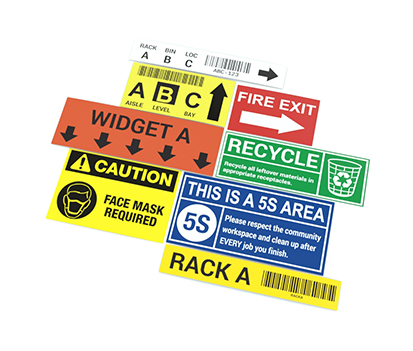
There are numerous different routes that a business can take when considering implementing a rack labeling strategy to improve their inventory management program. Each strategy works to improve communication and reduce the number of human errors in its own way, whether that be communicating via frequency, concerning the warehouse layout, or visual communication in the form of color coding.
Setting Up for Success
One of the primary strategies involved in a successful rack labeling project includes organizing the layout of the facility in a way that is intuitive to anyone, that includes new employees and visitors. To do that, there needs to be a systematic approach in which to lead those employees and visitors to the product they need quickly and efficiently. The secret to this is clearly marking zones, aisles, rack bays, shelves, and bins. The largest category begins with zones that then funnel down into smaller and smaller sections that eventually lead the one who is searching for a product to the bin or shelf where the product is located. Without this organizational strategy as a basis of a warehouse rack labeling system, no one would be able to find anything without memorizing the entire layout of the store or remembering where exact products are hidden away.
Color Coding
Another strategy that can be used for rack labeling is more on the visual side concerning color coding. This is a popular method because it allows for workers to identify a location with just a glance at the color of a label or sign. Color coding can be seen being used most often with totem pole labels on the vertical sides of tall racks. While denoting the location of items with those colors, the totem pole rack labels also allow for scanners to easily reach product barcodes.
Rack Label Materials
The last strategy for rack labeling involves choosing the materials used to label racks. All warehouses want to use cost effective but durable labels to maximize their operations. Some useful label materials include:
- Magnetic labels – These can be a good choice since they have the ability to be moved from place to place in case a warehouse changes where products are placed.
- Paper labels – These are some of the least expensive labels to buy and for that reason do not cost much to replace once a label becomes unreadable.
- Vinyl labels – These labels are very durable when exposed to substances like dirt, oil, water, and chemicals in the surrounding environment.
- Retro-reflective labels – These labels are helpful when employees must scan barcodes from a distance.
- Cold storage or heat resistant labels – Both of these kinds of labels are perfect for environments where temperature inhibits the durability of standard long lasting identification labels.
Overall, the company must develop a labeling system that works for their unique warehouse setup. It may take several attempts to get it just right, but the benefits are well worth the trouble.
Similar Questions
- What are bin location labels?
- What is a rack labeling system?
- What are the differences between rack labels, bin labels, and shelf labels?
- How can I Streamline Warehouse Operations with Rack Labeling?
- What supplies are needed for implementing a rack labeling system?
- Why is rack labeling important?
- What is the best system to keep track of inventory?
- What are the benefits of implementing a warehouse rack labeling system?
- What type of barcodes are used for rack labeling?

